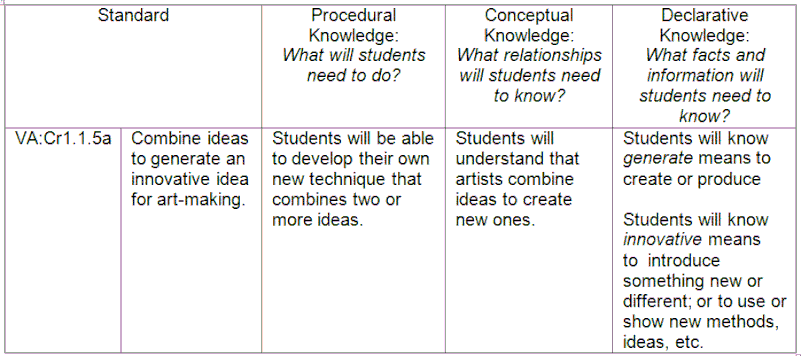Important steps In Designing UnitsStep 1: Determine & Unpack Standards Step 2: Group Standards into Units Step 3: Identify Enduring Understandings tied to standards Step 4: Decide Themes & Big Ideas to frame the unit Step 5: Design Essential Questions within the Unit Theme Step 6: Create Unit Performance Assessment to Assess Priority Standards Step 7: Write Lessons that Build Skills to the Assessment |
Step 1: Unpacking Standards First, it is very important to be familiar with what set of standards you plan on building your curriculum around. In UbD and Backward Design, "beginning with the end in mind" means knowing your desired learning results, then knowing how to assess evidence of learning, and finally planning the learning activities—this helps keep the focus on students' understanding.
Unpacking and deconstructing the different levels of knowledge embedded within each standard will help guide the development of assessments and scaffolding of lessons. When looking at a grade level performance standard, the first part of unpacking a standard into knowledge and skills is to identify the knowledge (what a student should know) and the skills (what a student should be able to do). You can start this process by simply underlining or highlighting the nouns and verbs within the standard. The nouns are the “what” and typically correspond to concepts a student should grasp and the verbs are the “how” and typically correspond to skills the student should be able to complete to demonstrate proficiency. Informally, our curriculum leaders often refer to the knowledge and skills chart as the "To Know's" and the "To Do's", but are more accurately broken down into three kinds of knowledge. Declarative knowledge refers to factual knowledge and information that a person knows. What will students know? Procedural knowledge, on the other hand, is knowing how to perform certain activities. What will students be able to do? In between comes Conceptual knowledge that is theoretical understandings students use to bridge the two. What will students understand? For example, to meet the 5th grade standard, "Combine ideas to generate an innovative idea for art-making" the three types of knowledge could be unpacked to include:
Once basic knowledge and skills have been identified, you should think critically about what each individual topic would look like in a classroom. Some concepts may need to be expanded to capture all of the details students would need to know to fully grasp the concept. A knowledge and skills chart, like the example below, can assist in detailing out the distinct pieces of information that will need to be addressed to ensure all of your students reach proficiency on the standard. Depending on the complexity of the standard, all knowledge and skills may not be able to be covered in one lesson. Breaking down the distinct concepts will assist you in planning how long the standard will take to cover completely. |
